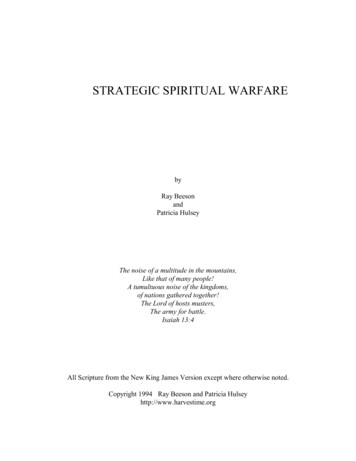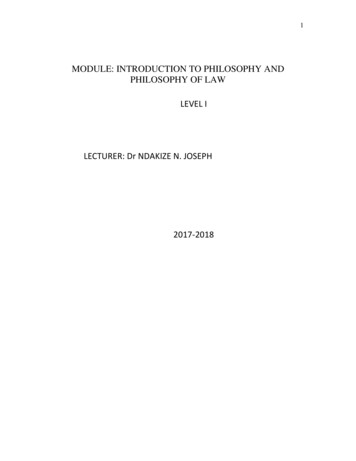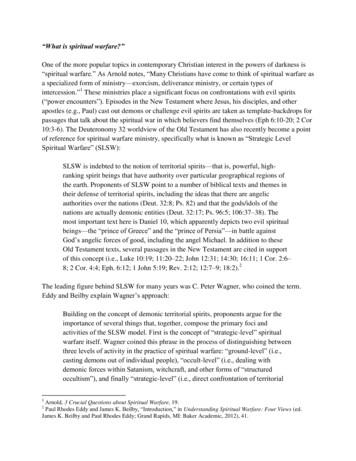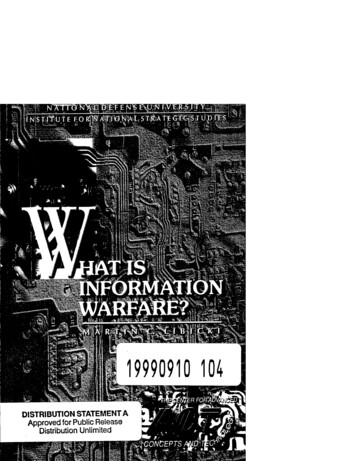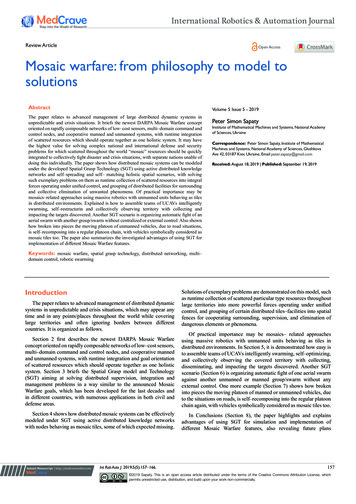
Transcription
International Robotics & Automation JournalReview ArticleOpen AccessMosaic warfare: from philosophy to model tosolutionsAbstractVolume 5 Issue 5 - 2019The paper relates to advanced management of large distributed dynamic systems inunpredictable and crisis situations. It briefs the newest DARPA Mosaic Warfare conceptoriented on rapidly composable networks of low–cost sensors, multi–domain command andcontrol nodes, and cooperative manned and unmanned systems, with runtime integrationof scattered resources which should operate together as one holistic system. It may havethe highest value for solving complex national and international defense and securityproblems for which scattered throughout the world “mosaic” resources should be quicklyintegrated to collectively fight disaster and crisis situations, with separate nations unable ofdoing this individually. The paper shows how distributed mosaic systems can be modeledunder the developed Spatial Grasp Technology (SGT) using active distributed knowledgenetworks and self–spreading and self– matching holistic spatial scenarios, with solvingsuch exemplary problems on them as runtime collection of scattered resources into integralforces operating under unified control, and grouping of distributed facilities for surroundingand collective elimination of unwanted phenomena. Of practical importance may bemosaics–related approaches using massive robotics with unmanned units behaving as tilesin distributed environments. Explained is how to assemble teams of UCAVs intelligentlyswarming, self–restructurin and collectively observing territory with collecting andimpacting the targets discovered. Another SGT scenario is organizing automatic fight of anaerial swarm with another group/swarm without centralized or external control. Also shownhow broken into pieces the moving platoon of unmanned vehicles, due to road situations,is self–recomposing into a regular platoon chain, with vehicles symbolically considered asmosaic tiles too. The paper also summarizes the investigated advantages of using SGT forimplementation of different Mosaic Warfare features.Peter Simon SapatyInstitute of Mathematical Machines and Systems, National Academyof Sciences, UkraineCorrespondence: Peter Simon Sapaty, Institute of MathematicalMachines and Systems, National Academy of Sciences, GlushkovaAve 42, 03187 Kiev, Ukraine, EmailReceived: August 18, 2019 Published: September 19, 2019Keywords: mosaic warfare, spatial grasp technology, distributed networking, multi–domain control, robotic swarmingIntroductionThe paper relates to advanced management of distributed dynamicsystems in unpredictable and crisis situations, which may appear anytime and in any points/places throughout the world while coveringlarge territories and often ignoring borders between differentcountries. It is organized as follows.Solutions of exemplary problems are demonstrated on this model, suchas runtime collection of scattered particular type resources throughoutlarge territories into more powerful forces operating under unifiedcontrol, and grouping of certain distributed tiles–facilities into spatialfences for cooperating surrounding, supervision, and elimination ofdangerous elements or phenomena.Section 2 first describes the newest DARPA Mosaic Warfareconcept oriented on rapidly composable networks of low–cost sensors,multi–domain command and control nodes, and cooperative mannedand unmanned systems, with runtime integration and goal orientationof scattered resources which should operate together as one holisticsystem. Section 3 briefs the Spatial Grasp model and Technology(SGT) aiming at solving distributed supervision, integration andmanagement problems in a way similar to the announced MosaicWarfare goals, which has been developed for the last decades andin different countries, with numerous applications in both civil anddefense areas.Of practical importance may be mosaics– related approachesusing massive robotics with unmanned units behaving as tiles indistributed environments. In Section 5, it is demonstrated how easy isto assemble teams of UCAVs intelligently swarming, self–optimizing,and collectively observing the covered territory with collecting,disseminating, and impacting the targets discovered. Another SGTscenario (Section 6) is organizing automatic fight of one aerial swarmagainst another unmanned or manned group/swarm without anyexternal control. One more example (Section 7) shows how brokeninto pieces the moving platoon of manned or unmanned vehicles, dueto the situations on roads, is self–recomposing into the regular platoonchain again, with vehicles symbolically considered as mosaic tiles too.Section 4 shows how distributed mosaic systems can be effectivelymodeled under SGT using active distributed knowledge networkswith nodes behaving as mosaic tiles, some of which expected missing.In Conclusions (Section 8), the paper highlights and explainsadvantages of using SGT for simulation and implementation ofdifferent Mosaic Warfare features, also revealing future plansSubmit Manuscript http://medcraveonline.comInt Rob Auto J. 2019;5(5):157‒166.157 2019 Sapaty. This is an open access article distributed under the terms of the Creative Commons Attribution License, whichpermits unrestricted use, distribution, and build upon your work non-commercially.
Copyright: 2019 SapatyMosaic warfare: from philosophy to model to solutionsfor continuation and extension of this research, new publicationsincluding.The DARPA mosaic conceptThe new DARPA’s Strategic Technology Office (STO) strategy, calledMosaic Warfare,1–8 seeks of getting a new asymmetric advantage, onethat imposes complexity on adversaries by harnessing the power ofdynamic, coordinated, and highly autonomous systems. This is byturning complexity into a powerful weapon via rapidly composablenetworks of low–cost sensors, multi–domain command andcontrol nodes, and cooperative manned and unmanned systems, assymbolically in Figure 1.1Figure 1 DARPA’s concept of “mosaic warfare.Under the mosaic approach, air, cyber, land, sea and space domainswill focus on operating in a more integrated framework. The newapproach also recognizes the reality that it will be impossible for theU.S. military to maintain an asymmetric technological advantage inthe form of advanced satellites, stealth aircraft and other systemsin the future. DARPA’s research and development efforts are alsofocusing on humanoid robots, artificial intelligence, synthetic biology,distributed space architectures, hypersonics and quantum sensing.Advances in microelectronics and communications are makingpossible a degree of networked coordination and collaborationbetween different systems almost unimaginable just a few years ago.This, in turn, is enabling distributed system–of–systems architecturesthat will be more resilient to attack, less costly to develop and faster toupgrade when compared to today’s centralized expensive monolithicsystem.The mosaic approach will require a shift in military policy fromdominance to “lethality”. It is believed that various domains currentlyspend too much time; money and effort in trying to ensure its weaponssystems are more advanced than adversaries. It’s imperative to focus onlethality and the ability to win regardless of whose individual weaponssystem is the best. A fundamental way to achieve this lethality is bydistributing and disaggregating the sensors and weapons that todayare tightly bound together and integrated on monolithic platforms.Efforts of various domains to engage in the concept of joint multi–domain battle in recent years have been limited by the degree ofmachine–to–machine connectivity available to them today. Instead,a future is considered where computers will be distributed across thebattle space, and can all communicate and coordinate with each other.Traditional asymmetric technology advantage is now lower than it oncewas, due to increased global access to comparable high–tech systemsand components, many of which are now commercially available.The military has found that high cost and sometimes decades–longdevelopment of new systems are unable to compete with the fastrefresh rate of commercial electronics technology, which can make158new military systems obsolete before they’re even delivered. Withinmosaic concept to warfare, lower–cost, less complex systems may belinked together in a vast number of ways to create desired, interwoveneffects tailored to any scenario.The individual parts of a mosaic are attritable but together areinvaluable for how they contribute to the whole. This means that evenif an adversary can neutralize a number of pieces of the mosaic, thecollective can instantly respond as needed to still achieve the desired,overall effect. A tile in a mosaic is one small part of a bigger picture,as in Figure 2.2 if you lose one tile, this should not be a big deal, as thewhole picture remains understandable and functional.Figure 2 Mosaic picture with missing tiles but still understandable content.The mosaic concept also fundamentally differs from the traditional“system of systems” model, where each part is uniquely designedand integrated to fill a specific role. Mosaic warfare envisions abottom–up composition capability, where individual elements, likeindividual tiles in a mosaic, are combined to create an effect in waysnot previously contemplated, and potentially dynamically.Unlike today’s monolithic systems and rigid architectures thattake decades to develop, Mosaic Warfare is expected to utilize rapidmachine–to–machine interoperability and AI to network mannedand unmanned systems together, creating resilient and distributedarchitectures at campaign, and eventually, mission speeds. Itfocuses on speed and adaptation, networking sensors, command andcontrol, and effects together across domains to form solutions thatadapt to dynamic threats and environments, orienting on creation ofresilient systems that retain legacy capabilities, but mitigating thevulnerabilities of monolithic systems.The new DARPA approach, in our opinion, may have muchgreater, including philosophical and psychological, sense anddimension rather than just uniting distributed casual forces. Thismay inevitably connect it with the Gestalt psychology and theory9–13proclaiming unique capability of human mind and brain to directlygrasp the whole of phenomena while treating parts, which may beincomplete, in the context of this whole rather than vice versa. TheSpatial Grasp model and Technology, briefed in the next section, isjust attempting to conceptually and practically catch this wholeness,of distributed dynamic systems too, which can be particularly usefulfor this DARPA mosaics concept.Spatial grasp technology (SGT)We are providing here only main ideas of SGT on which thereare many available sources including European patent,14 John Wiley,Springer and Emerald books,15–19 as well as numerous publicationsCitation: Sapaty PS. Mosaic warfare: from philosophy to model to solutions. Int Rob Auto J. 2019;5(5):157‒166. DOI: 10.15406/iratj.2019.05.00190
Copyright: 2019 SapatyMosaic warfare: from philosophy to model to solutionsof different technology versions along with their networkedimplementations and diverse applications.20–68Within SGT, a high–level scenario for any task to be performed ina distributed world is represented as an active self–evolving patternrather than traditional program, sequential or parallel. This pattern,written in a high–level Spatial Grasp Language (SGL) and expressingtop semantics of the problem to be solved, can start from any worldpoint as a source of pattern’s activity. It then spatially propagates,replicates, modifies, covers and matches the distributed world in aparallel wavelike mode, while echoing the reached control states anddata found or obtained by given operations (which may be arbitrarilyremote) for making decisions and processing at higher levels, withfurther space navigation from new or previously reached points, andso on. This inherently parallel and fully distributed spatial sping–echoingprocessissymbolically shown in Figure 3 together with its simplified physicalanalogy.159The created infrastructures, which may be left active, can effectivelysupport or express distributed databases, command and control,situation awareness, autonomous and collective decisions, as wellas any other existing or hypothetical computational and/or controlmodels (like, say, neural networks or Petri nets). They can also be theresult of spatial matching of arbitrary graph–based patterns in SGLwith already existing knowledge networks previously organized bySGT or any other models and technologies.SGL has a deep recursivestructure with its top level shown below, also in Figure 6, whichreflects the ��echoingnature of SGL scenarios (where words in italics represent syntacticcategories, square brackets show optional constructs, braces indicaterepetitive parts, and parentheses and comma being the languagesymbols).Figure 3 The basic idea of SGT: a) controlled echoed space navigation &matching; b) symbolic physical analogy.Many spatial processes in SGL can start any time and from any worldplaces and develop simultaneously worldwide while cooperating orcompeting with each other, depending on applications, as in Figure 4.Figure 4 Multi-source space coverage & matching.The self–spreading and self–matching SGL patterns can createknowledge infrastructures arbitrarily distributed between systemcomponents having embedded SGL interpreters, which may coverany regions, the whole world including, as in Figure 5.Figure 6 SGL recursive syntax.The SGL scenario can dynamically spread & process & match theworld or its parts needed, with scenario code capable of virtuallyor physically splitting, replicating, modifying and moving in thedistributed spaces being accompanied with transitional data (includingin special frontal variables). This movement can take place in singleor multiple scenario parts dynamically and spatially interlinked underthe overall control, which is spreading, covering, and matching thenavigated world too.Numerous communicating SGL interpreter copies can be installedworldwide in thousands to millions to billions of copies and integratedwith other systems or operate autonomously in critical situations.They are forming altogether a sort of global collective spatial braingoverned on top level by multiple and freely moving soul–likerecursive scenarios in SGL.SGT–based distributed mosaic simulationWe will be symbolically representing the mosaic space here by aregular distributed network model expressed in SGT with possibilityof some nodes missing, also showing exemplary nonlocal operationson it which may need a sort of holistic vision of this distributed spaceto be successful.Networked representation of mosaic spaceSymbolic mosaic space consisting of differently colored tiles–units is shown in Figure 7, assuming the tiles representing nodes of aregular distributed network, with colors reflecting different orientation(or content) of the nodes.Figure 5 Spreading spatial patterns and creation of distributed infrastructures.The tiles–nodes may have different links with surrounding nodes.We are assuming here that each node has links with four directCitation: Sapaty PS. Mosaic warfare: from philosophy to model to solutions. Int Rob Auto J. 2019;5(5):157‒166. DOI: 10.15406/iratj.2019.05.00190
Mosaic warfare: from philosophy to model to solutionsneighbors, if all exist, having common edges with them, as in Figure8a (on its up, down, left, and right). It may also have additional linkswith the four corner neighbors (if all exist too) as in Figure 8b, thusgenerally having eight all neighbors in total, as in Figure 8c, if all suchneighbors are present in the mosaic picture.Figure 7 Mosaic space simplified model.Copyright: 2019 Sapaty160hop(Heads); hop(Subordinates), stay; perform(action)With a slight scenario complication, we could also appoint headsof the obtained groups as being topologically most central to the othergroup members, say, for more effective command and control of thewhole groups, like shown in Figure 10.Figure 9 Grouping of direct neighbors under threshold given.Figure 8 Links to neighboring tiles: a: direct neighbors; b: corner neighbors;c: all neighbors.We will be showing below two exemplary distributed mosaics–related tasks and their solutions on this simplified networked model.Grouping particular type neighboring elementsThe task is to find all fully interconnected groupings of units (asdirect neighbors to each other) of particular type (let it be pink) withgiven threshold number of components in such groups (say, not lessthan 4), and fix their entry or head units. This task may, for example,relate to runtime grouping of certain distributed military or securityunits into more powerful forces with each under united control.The related SGL scenario may be as follows (starting in parallel inall networked tiles–nodes, with the obtained resultant nodes–entriesin each group having their names–values like X–Y coordinates asmaximum in relation to the other group nodes):Figure 10 A better solutions for entry nodes of the groups found.Collective surrounding and impacting of a dangerelementHaving discovered some alien or dangerous element in thedistributed mosaic (like the tile in black in Figure 11), let us try to findthe nearest full chain or “fence” around it consisting of certain (letthem be pink again) elements (generally linked by all neighbors toeach other). Such full chain, if exists, will not let the danger elementescape (assumed capable of moving only via non–pink tiles and asdirect neighbors to each other.hop(Headquarters);nodal(Heads, Threshold 4, Subordinates); Heads (hop(all);TYPE pink; IDENTITY NAME; hopfirst(current);Subordinates contain(repeat(hopfirst(direct neighbors); COLOR pink; if(NAME IDENTITY, abort); blind(NAME), stay);count(Subordinates) 1 Threshold; NAME); output(Heads)The issued result will be: Name1, Name2, Name3 (with these headnames corresponding to the related X–Y node coordinates) as shownin Fig. 9, where the groped pink elements highlighted in red.Example of a global order delivering some action commandto all heads of the obtained integrated forces and then to their allsubordinates (with both heads and subordinates, registered at heads,obliged of executing it) may be as follows:Figure 11 Discovering a danger element on distributed mosaics.The following scenario is supposed to be applied from some missionHeadquarters, which may be inside or outside the considerednetworked model. Starting from the black tile with known Dangercoordinates, it spreads in parallel throughout the tiled space via non–pink tiles as direct neighbors, and as far as possible, with blockingCitation: Sapaty PS. Mosaic warfare: from philosophy to model to solutions. Int Rob Auto J. 2019;5(5):157‒166. DOI: 10.15406/iratj.2019.05.00190
Copyright: 2019 SapatyMosaic warfare: from philosophy to model to solutionscycling to the already visited tiles. This is being done unless meetsthe first pink tiles, where it stops, as shown in Figure 12 (these finallyreached pink tiles are highlighted now in red too).161hop(Headquarters);frontal(Depth) max distance; nodal(Mark, Names); Names contain(hopfirst(Danger coordinates);repeat(COLOR! pink;hopfirst(direct neighbors);decrement(Depth, 1); if(Depth 0, abort));Mark 1; NAME);if(count(Names) 0,quit(output(“failure”)), hop(Names)); parallel(trace destroy(Danger coordinates),(hop(all neighbors); Mark 1;Figure 12 Finding a full chain of certain elements surrounding the danger tile.The found names–addresses of nodes of this nearest fence areechoed to the Headquarters which then issues general command tothem all to trace and destroy this black tile which may be moving,at any time they could be able to, which is accomplished by thefollowing scenario.hop(Headquarters);assist destroy(Danger coordinates)))Being fully surrounded by the red perimeter, the danger object(which may be trying to move and escape) will be constantly analyzedby all the perimeter units having received its coordinates and thedestruction or assistance order, and finally caught or destroyed bysome, say, closest to it red unit in cooperation with its neighbors, asshown in Figure 14.nodal(Names) (hopfirst(Danger coordinates);repeat(COLOR ! pink; hopfirst(direct neighbors)); NAME);hop(Names);trace destroy(Danger coordinates)Let us make this scenario a bit more advanced. In the current solution,if no full chain of pink tiles exists around the Danger element, thespreading parallel spanning tree algorithm may not stop at all, or canjust reach the tiled space boundaries if they are limited in distance. Wemay introduce certain allowed max distance using variable Depth toforcefully stop this tree–spreading process if it exceeds the alloweddepth, with indication and warning that the closed fence solutionaround the danger cannot be found. Also, in case of existence of theclosed fence, we may involve in the tracing–destroying operationnot only each finally reached pink (now red) tile separately, but alsowith their direct all neighbors also belonging to the fence, say, byasking simultaneously the latter to assist in this operation. This settingcooperation between all perimeter neighbors, like of integral system,as shown in Figure 13 and by the extended SGL scenario that follows.Figure 14 The final elimination of the danger object.An extended surrounding scenarioThe scenario above presumed that coordinates of the danger objectwere given in advance. But we may complicate and extend this scenarioby adding initial analysis of the whole network on the presence ofsuch dangerous, or black, tiles there (which may be more than one)with the return of their exact coordinates to the Headquarters. We mayfurther organize in SGT parallel finding of individual fences for alldiscovered danger objects (such fences may happen to be commonfor more than one danger object) with issuing personal commands totrace and destroy them, as follows.hop(Headquarters);nodal(Targets) (hop(all nodes); COLOR black; ADDRESS);nonempty(Targets); split(Targets); frontal(Target) VALUE;IDENTITY Target; nodal(Mark, Names); frontal(Depth) maxdistance; Names contain(hopfirst(Target);Figure 13 Setting cooperation between all neighboring elements of the fullchain found.repeat(COLOR! pink;hopfirst(direct neighbors);decrement(Depth, 1); if(Depth 0, abort));Mark 1; NAME);Citation: Sapaty PS. Mosaic warfare: from philosophy to model to solutions. Int Rob Auto J. 2019;5(5):157‒166. DOI: 10.15406/iratj.2019.05.00190
Copyright: 2019 SapatyMosaic warfare: from philosophy to model to solutionsif(count(Names)hop(Names)); 0,stop(output(“failure”,Target)),repeat(Shift random(Limits);if(empty(Shift, Range), WHERE Shift); sleep(delay))parallel(trace destroy(Target),Finding topologically central unit(hop(all neighbors); Mark 1;assist destroy(Target)))More realistic links between mosaic tilesIn the examples above, we used some hypothetical mosaics modelin the form of regular two–dimensional network structure (withpossibility of some nodes missing), just to show how some SGTand SGL mechanisms could work in principle in fully distributedenvironments. In reality for this DARPA mosaics concept, linksbetween mosaic elements may be more complex, irregular, notfixed in advance, but rather appearing dynamically, at runtime. Theexamples in the following sections are just describing such situationswhere mosaic elements may be represented as separate manned orunmanned units trying to solve different problems cooperatively, withthe help of SGT.Combining swarmingcommand and control162withAfter finding such central unit, as in Figure 16, hopping into it,while starting this center finding from any unit, calling this as findhop center.frontal(Aver) average(hop(all nodes); WHERE);min destination(hop(all nodes); distance(Aver, WHERE))hierarchicalImagine that a distributed area needs to be investigated by multipleunmanned aerial vehicles that should randomly search the space,collect information on unwanted objects classifying them as targets,and organize collective reaction on the emerging threats. Differentgroup functionalities for this can be expressed in SGL and effectivelyintegrated into the resultant holistic group scenario, as follows,with more details on the related scenarios can be found in existingpublications, including.15–17Figure 16 Runtime finding of central unit.Creating runtime operational infrastructureThe infrastructure creation is starting from the found central unitwith the use of oriented semantic links infra and maximum physicaldistance or Depth between nodes allowed to form direct control andoperational links, let this be named infra build, see also Figure 17.Initial distribution of networked unitsThese units, like UCAVs, are presumed having embedded SGLinterpreters (U), which can communicate, as shown in Figure 15. Theircollective behavior (any imaginable or even so far unimaginable) canbe organized by self–navigating spatial scenarios in SGL which canstart from any unit and operate in parallel and fully distributed mode,without dedicated in advance centralized or external control facilities.Figure 17 Creating runtime distributed operational infrastructure.frontal(Depth 300); firstcome(current); repeat(linkup( infra,firstcome, Depth))Figure 15 Networked UCAVs.Swarm movement scenarioRandomized (within certain Limits) swarm movement ofindividual UCAVs, starting in any node and with minimum allowedthreshold or Range distance between them can be organized by thefollowing scenario (let us call this as swarm move):hop(all nodes);nodal(Limits (dx(0,8), dy(–2,5)), Range 200, Shift);Providing more details for this infrastructure creation, with firstremoving previous infrastructure links, if any:frontal(Depth 300); firstcome(current); repeat(hop(firstcome,Depth);stay unlink(all); linkup(–infra, BACK))Targets collection & distribution & impactThis distributed operation of discovering targets by individualunits throughout the area covered, their collection in one point andfurther distribution to all units engaged, will be starting from thecentral unit found (naming this stage collect distribute impact), withCitation: Sapaty PS. Mosaic warfare: from philosophy to model to solutions. Int Rob Auto J. 2019;5(5):157‒166. DOI: 10.15406/iratj.2019.05.00190
Copyright: 2019 SapatyMosaic warfare: from philosophy to model to solutionsthe following scenario:frontal(Seen) repeat(free detect(targets), hop links( infra));nonempty(Seen);repeat(free select shoot(Seen), hop links( infra))Full scenario integrationUsing the accumulated SGL scenarios for different behavioralstages, as above, we can easily integrate them within the globalbehavioral & operational scenario. The resultant combined scenariowill be uniting the previous SGL–based solutions named in bold whilestarting from any unit, and will be as follows (where threshold timemeans certain allowed time interval):hop(random, all nodes);parallel(swarm move,repeat(find hop center; stay(infra build);allowed(threshold time,sling(collect distribute impact))))The obtained resultant scenario combines loose and randomlysemi–oriented swarm movement in a distributed space with periodicupdating of topologically central unit (as units are changing distancesand relative positions in space), and regularly forming updatedhierarchical infrastructure between them starting from the newcentral units. This infrastructure controls observation of distributedterritory with collection of potential targets at the current central units,distributing them back to the vehicles for local assessment, selectionand impact of most available or suitable targets.Swarm against swarm aerial scenarioAs a more complex scenario example in SGL we will considerhere the case where an unmanned aerial swarm is fighting anothermanned or unmanned group/swarm, with symbolic swarms shownin Figure 18. More details on similar solutions can be found in thementioned existing publications on SGT,15–17 including.163a. Initial launch of the swarmed units (let us call them “chasers”),shown in Figure 17 with embedded SGL interpreters U whichcan communicate with each other, into the expected conflictarea.b. Starting from randomly chosen unit, connecting with otherchasers which collect and send back data on the hostile objects,as “targets”, seen in their vicinity.c. Forming the targets priority list by their locations in physicalspace, with maximum priority assigned to topologicallycentral targets as potential control units of the enemy’s group.d. Other targets are sorted by their distances from the topologicalcenter of their group.e. Most peripheral targets, i.e. those in maximum distance fromthe topological center, are considered with higher (evenhighest) priority too, as potentially having more chances toescape.f. Assigning available chasers to most appropriate targets,classifying these chasers as engaged, with chasing &neutralizing the targets and subsequently returning into thestatus vacant after successful performance i.e. if not destroyedthemselves. The vacant chasers are again engaged in thetargets selection & impact procedure, and so on.g. If all collected targets processed, repeating the whole scenariofrom another randomly chosen chaser, if still exist, i.e. fromstep 2 for the search and impact of new targets, and so on.This potentially parallel and distributed swarm–against–swarmscenario can be expressed in SGL in a compact form, as follows:frontal(Chasers) , Targets,repeat(hop(random, Chasers, vacant);Next,List,Center);Targets Targets); Center average(Targets);List sortdown(split(Targets); distance(VALUE, Center)& VALUE); List append(withdraw(List, last), List)
Aug 18, 2019 · Introduction The paper relates to advanced management of distributed dynamic . large territories into more powerful forces operating under unified control, and grouping of certain distributed tiles–facilities into spatial . Mosaic warfare: from philosophy to mode
